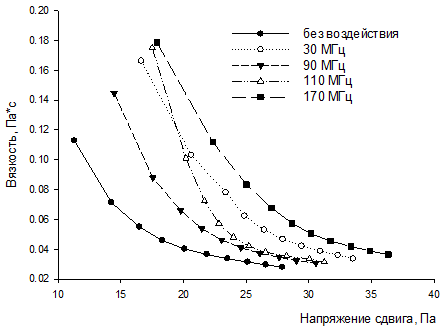ABNORMAL RHEOLOGY OF AGAR-AGAR SOLUTIONS PREPARED USING WATER EXPOSED TO AN ELECTRO-MAGNETIC FIELD
UDC 532.135
Abstract
The paper presents the results of a study of the rheological properties of agar-agar solutions prepared using water exposed to an electromagnetic field with a frequency of 30 to 170 MHz. The studies were carried out at three temperatures: 25, 35, 45 °С, the concentration varied from 0.1 to 0.7%, and the shear rate varied in the range of 100–1000 s-1. As a result of the study, a distinct influence of the electromagnetic field was found, and the quantitative response depends on the shear rate, solution concentration, temperature and frequency of the electromagnetic field. In the vast majority of cases, a decrease in the viscosity of solutions is observed as a result of exposure to an electromagnetic field. There is practically no quantitative correlation of viscosity changes with frequency. There is a complex picture of the mutual influence of the solution concentration, the frequency of the electromagnetic field, temperature and shear rate when measuring viscosity. The temperature dependence of viscosity for solutions subjected to and not exposed to an electromagnetic field is multidirectional in nature and substantially depends on both the concentration of the solution, the frequency of the electromagnetic field, and the shear rate at which measurements were taken.
An explanation of the observed dependencies is proposed, which is based on the two-component agar-agar solutions, which leads to individualization of the changes in the rheological properties determined by agarose and agaropectin, respectively.
Downloads
Metrics

Copyright (c) 2020 chemistry of plant raw material

This work is licensed under a Creative Commons Attribution 4.0 International License.

This work is licensed under a Creative Commons Attribution 4.0 International License.
The authors, which are published in this journal, agree to the following conditions:
1. Authors retain the copyright to the work and transfer to the journal the right of the first publication along with the work, at the same time licensing it under the terms of the Creative Commons Attribution License, which allows others to distribute this work with the obligatory indication of the authorship of this work and a link to the original publication in this journal .
2. The authors retain the right to enter into separate, additional contractual agreements for the non-exclusive distribution of the version of the work published by this journal (for example, to place it in the university depository or to publish it in a book), with reference to the original publication in this journal.
3. Authors are allowed to post their work on the Internet (for example, in a university repository or on their personal website) before and during the review process of this journal, as this may lead to a productive discussion, as well as more links to this published work.











